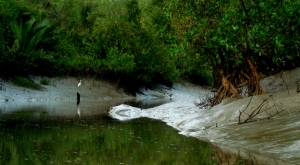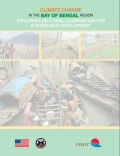Newsroom :: News :: Learnings on climate change adaptation in the Bay of Bengal documented in new book
Learnings on climate change adaptation in the Bay of Bengal documented in new book
Location: Bangkok, Thailand. 16th Jan 2017
In their articles, the specialists, from the US Exchange Programme Alumni, evaluated both climate change adaptation and mitigation approaches undertaken in their countries. They also outlined necessary actions to enhance regional cooperation to combat climate change, and to achieve sustainable development in the Bay of Bengal region.
Bangladesh is one of the most climate vulnerable countries today, but is often called the ‘adaptation capital of the world’ because of its exciting progress in mitigating the effects of climate change. Social, economic, political and climatic systems are continuously changing at the national, regional and global levels. It is, therefore, important to keep the pace of climate change adaptation going by taking innovative steps and actions in relevant arenas. These areas could range from policy to finance to institutions to technology.
In the Bangladesh Chapter entitled ‘What Does Bangladesh Tell Us About Innovation In Climate Change Adaptation,' Haseeb Md. Irfanullah of IUCN Bangladesh has considered three related areas of climate change adaptation:
- Adaptation planning and implementation,
- Nature-based adaptation technology development and diffusion, and
- Evolution in programmatic approach.
The chapter touches on major developments in these areas between 2006 and mid-2016 through an 'innovation lens.' The author considers 2006 the base year, because Bangladesh prepared the National Adaptation Programme of Action (NAPA) – the first ever strategic document in Bangladesh to make climate change adaptation an organised effort -- in 2005.
The article draws on examples from Bangladesh’s coast and talks about the adaptation approaches undertaken, the opportunities created by them, and their impacts on people and nature. It further discusses the challenges faced by innovations in adaptation and how they can be transformed into opportunities.
The paper advocates evaluation of adaptation innovations, before and after scaling up, to avoid maladaptation. It emphasises knowledge generation and management as a key component of adaptation projects for informed decision-making. It argues that such initiatives should have a 'monitoring, learning and evaluation system' built within them – a useful approach strengthened under the Mangroves for the Future initiative.
Such an arrangement can help to create a dynamic environment for projects to harness innovation at individual, institutional and policy levels, and at the same time make them more effective.
The book was published by COAST Trust (an NGO in Bangladesh) with support from the United States Department of State.

One of the beautiful canals of the Bangladesh Sundarbans, Bagerhat, Khulna, Bangladesh © Enamul Mazid Khan Siddique, 2011
Related Documents

What Does Bangladesh Tell Us About Innovation In Climate Change Adaptation
Author: Haseeb Md. Irfanullah
Posted on: 17th Jan 2017
Category: Asia Region (Secretariat)
Size: 461 KB